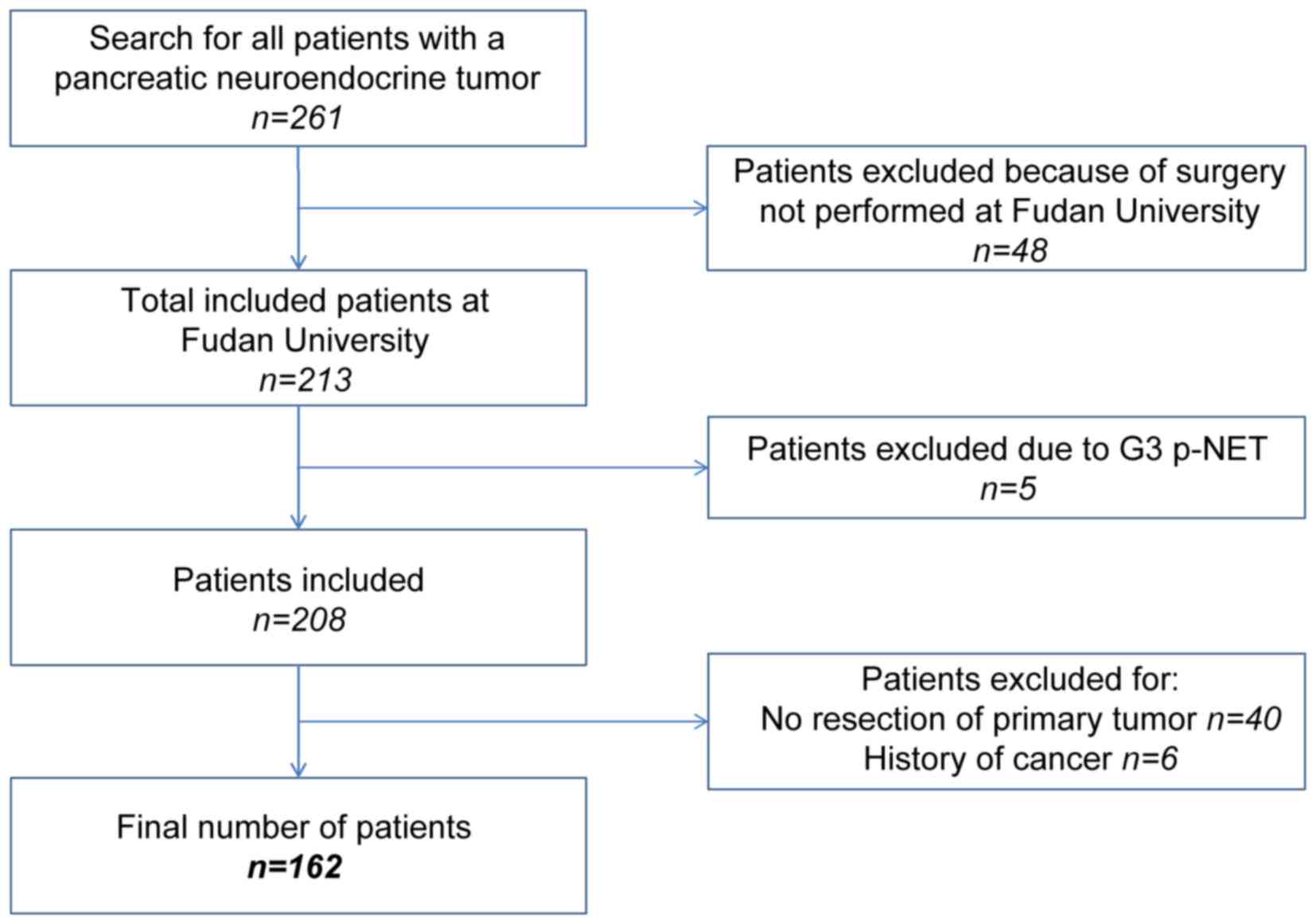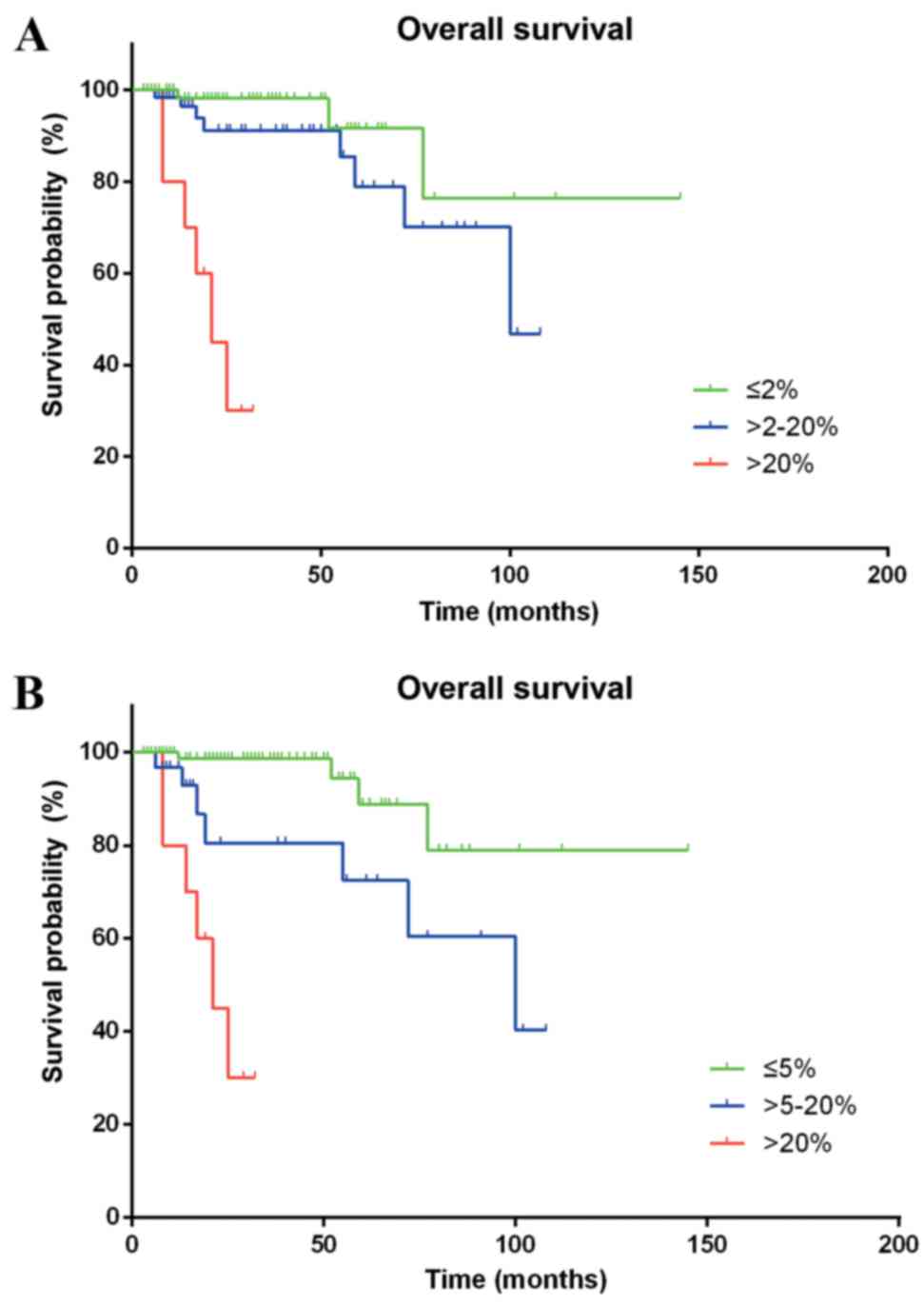|
1
|
Yao JC, Hassan M, Phan A, Dagohoy C, Leary
C, Mares JE, Abdalla EK, Fleming JB, Vauthey JN, Rashid A and Evans
DB: One hundred years after ‘carcinoid’: Epidemiology of and
prognostic factors for neuroendocrine tumors in 35,825 cases in the
United States. J Clin Oncol. 26:3063–3072. 2008. View Article : Google Scholar : PubMed/NCBI
|
|
2
|
Tsai HJ, Wu CC, Tsai CR, Lin SF, Chen LT
and Chang JS: The epidemiology of neuroendocrine tumors in Taiwan:
A nation-wide cancer registry-based study. PLoS One. 8:e624872013.
View Article : Google Scholar : PubMed/NCBI
|
|
3
|
Capella C, Heitz PU, Höfler H, Solcia E
and Klöppel G: Revised classification of neuroendocrine tumours of
the lung, pancreas and gut. Virchows Arch. 425:547–560. 1995.
View Article : Google Scholar : PubMed/NCBI
|
|
4
|
Solcia E, Klöppel G and Sobin LH:
Histological Typing of Endocrine TumorsWHO International
Histological Classification of Tumors. Springer; Berlin, Germany:
2000
|
|
5
|
Rindi GAR and Bosman FT: ea: Nomenclature
and classification of neuroendocrine neoplasms of the digestive
systemBosman T, Carneiro F, Hruban R, et al: In: Bosman T, Carneiro
F, Hruban R, et al (eds). WHO Classification of Tumours of
the Digestive System. 4th. Lyon, France: International Agency for
Research on Cancer (IARC); 3. pp. 4172010
|
|
6
|
Rindi G, Klöppel G, Alhman H, Caplin M,
Couvelard A, de Herder WW, Erikssson B, Falchetti A, Falconi M,
Komminoth P, et al: TNM staging of foregut (neuro)endocrine tumors:
A consensus proposal including a grading system. Virchows Arch.
449:395–401. 2006. View Article : Google Scholar : PubMed/NCBI
|
|
7
|
Edge SBBDR and Compton CC: ea. AJCC Cancer
Staging Manual. New York, NY: Springer; 2010
|
|
8
|
Panzuto F, Boninsegna L, Fazio N, Campana
D, Brizzi Pia M, Capurso G, Scarpa A, De Braud F, Dogliotti L,
Tomassetti P, et al: Metastatic and locally advanced pancreatic
endocrine carcinomas: Analysis of factors associated with disease
progression. J Clin Oncol. 29:2372–2377. 2011. View Article : Google Scholar : PubMed/NCBI
|
|
9
|
Kulke MH, Bendell J, Kvols L, Picus J,
Pommier R and Yao J: Evolving diagnostic and treatment strategies
for pancreatic neuroendocrine tumors. J Hematol Oncol. 4:292011.
View Article : Google Scholar : PubMed/NCBI
|
|
10
|
Dixon E and Pasieka JL: Functioning and
nonfunctioning neuroendocrine tumors of the pancreas. Curr Opin
Oncol. 19:30–35. 2007. View Article : Google Scholar : PubMed/NCBI
|
|
11
|
Cheema A, Weber J and Strosberg JR:
Incidental detection of pancreatic neuroendocrine tumors: An
analysis of incidence and outcomes. Ann Surg Oncol. 19:2932–2936.
2012. View Article : Google Scholar : PubMed/NCBI
|
|
12
|
Haugvik SP, Janson ET, österlund P, Langer
SW, Falk RS, Labori KJ, Vestermark LW, Grønbæk H, Gladhaug IP and
Sorbye H: Surgical treatment as a principle for patients with
high-grade pancreatic neuroendocrine carcinoma: A nordic
multicenter comparative study. Ann Surg Oncol. 23:1721–1728. 2016.
View Article : Google Scholar : PubMed/NCBI
|
|
13
|
Kim MJ, Choi DW, Choi SH, Heo JS, Park HJ,
Choi KK, Jang KT and Sung JY: Surgical strategies for
non-functioning pancreatic neuroendocrine tumours. Br J Surg.
99:1562–1568. 2012. View
Article : Google Scholar : PubMed/NCBI
|
|
14
|
Hill JS, McPhee JT, McDade TP, Zhou Z,
Sullivan ME, Whalen GF and Tseng JF: Pancreatic neuroendocrine
tumors: The impact of surgical resection on survival. Cancer.
115:741–751. 2009. View Article : Google Scholar : PubMed/NCBI
|
|
15
|
Franko J, Feng W, Yip L, Genovese E and
Moser AJ: Non-functional neuroendocrine carcinoma of the pancreas:
Incidence, tumor biology, and outcomes in 2,158 patients. J
Gastrointest Surg. 14:541–548. 2010. View Article : Google Scholar : PubMed/NCBI
|
|
16
|
Cusati D, Zhang L, Harmsen WS, Hu A,
Farnell MB, Nagorney DM, Donohue JH, Que FG, Reid-Lombardo KM and
Kendrick ML: Metastatic nonfunctioning pancreatic neuroendocrine
carcinoma to liver: Surgical treatment and outcomes. J Am Coll
Surg. 215:117–125. 2012. View Article : Google Scholar : PubMed/NCBI
|
|
17
|
Ekeblad S, Skogseid B, Dunder K, Oberg K
and Eriksson B: Prognostic factors and survival in 324 patients
with pancreatic endocrine tumor treated at a single institution.
Clin Cancer Res. 14:7798–7803. 2008. View Article : Google Scholar : PubMed/NCBI
|
|
18
|
Ballian N, Loeffler AG, Rajamanickam V,
Norstedt PA, Weber SM and Cho CS: A simplified prognostic system
for resected pancreatic neuroendocrine neoplasms. HPB (Oxford).
11:422–428. 2009. View Article : Google Scholar : PubMed/NCBI
|
|
19
|
Fischer L, Bergmann F, Schimmack S, Hinz
U, Prieß S, Müller-Stich BP, Werner J, Hackert T and Büchler MW:
Outcome of surgery for pancreatic neuroendocrine neoplasms. Br J
Surg. 101:1405–1412. 2014. View
Article : Google Scholar : PubMed/NCBI
|
|
20
|
Bettini R, Boninsegna L, Mantovani W,
Capelli P, Bassi C, Pederzoli P, Fave GF Delle, Panzuto F, Scarpa A
and Falconi M: Prognostic factors at diagnosis and value of WHO
classification in a mono-institutional series of 180
non-functioning pancreatic endocrine tumours. Ann Oncol.
19:903–908. 2008. View Article : Google Scholar : PubMed/NCBI
|
|
21
|
Boninsegna L, Panzuto F, Partelli S,
Capelli P, Fave G Delle, Bettini R, Pederzoli P, Scarpa A and
Falconi M: Malignant pancreatic neuroendocrine tumour: Lymph node
ratio and Ki67 are predictors of recurrence after curative
resections. Eur J Cancer. 48:1608–1615. 2012. View Article : Google Scholar : PubMed/NCBI
|
|
22
|
Khan MS, Luong TV, Watkins J, Toumpanakis
C, Caplin ME and Meyer T: A comparison of Ki-67 and mitotic count
as prognostic markers for metastatic pancreatic and midgut
neuroendocrine neoplasms. Br J Cancer. 108:1838–1845. 2013.
View Article : Google Scholar : PubMed/NCBI
|
|
23
|
Rindi G, Falconi M, Klersy C, Albarello L,
Boninsegna L, Buchler MW, Capella C, Caplin M, Couvelard A,
Doglioni C, et al: TNM staging of neoplasms of the endocrine
pancreas: Results from a large international cohort study. J Natl
Cancer Inst. 104:764–777. 2012. View Article : Google Scholar : PubMed/NCBI
|
|
24
|
Vélayoudom-Céphise FL, Duvillard P, Foucan
L, Hadoux J, Chougnet CN, Leboulleux S, Malka D, Guigay J, Goere D,
Debaere T, et al: Are G3 ENETS neuroendocrine neoplasms
heterogeneous. Endocr Relat Cancer. 20:649–657. 2013. View Article : Google Scholar : PubMed/NCBI
|
|
25
|
Hashim YM, Trinkaus KM, Linehan DC,
Strasberg SS, Fields RC, Cao D and Hawkins WG: Regional
lymphadenectomy is indicated in the surgical treatment of
pancreatic neuroendocrine tumors (PNETs). Ann Surg. 259:197–203.
2014. View Article : Google Scholar : PubMed/NCBI
|
|
26
|
Strosberg JR, Cheema A, Weber J, Han G,
Coppola D and Kvols LK: Prognostic validity of a novel american
joint committee on cancer staging classification for pancreatic
neuroendocrine tumors. J Clin Oncol. 29:3044–3049. 2011. View Article : Google Scholar : PubMed/NCBI
|
|
27
|
Wong J, Fulp WJ, Strosberg JR, Kvols LK,
Centeno BA and Hodul PJ: Predictors of lymph node metastases and
impact on survival in resected pancreatic neuroendocrine tumors: A
single-center experience. Am J Surg. 208:775–780. 2014. View Article : Google Scholar : PubMed/NCBI
|
|
28
|
Garcia-Carbonero R, Sorbye H, Baudin E,
Raymond E, Wiedenmann B, Niederle B, Sedlackova E, Toumpanakis C,
Anlauf M, Cwikla JB, et al: ENETS consensus guidelines for
high-grade gastroenteropancreatic neuroendocrine tumors and
neuroendocrine carcinomas. Neuroendocrinology. 103:186–194. 2016.
View Article : Google Scholar : PubMed/NCBI
|
















